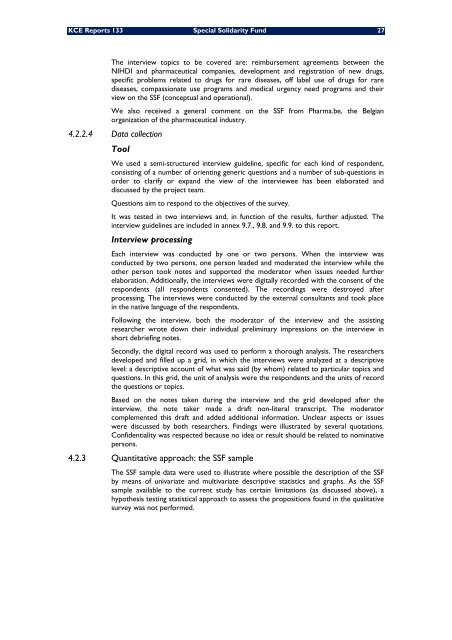Optimalisatie van de werkingsprocessen van het Bijzonder ... - KCE
Optimalisatie van de werkingsprocessen van het Bijzonder ... - KCE
Optimalisatie van de werkingsprocessen van het Bijzonder ... - KCE
Create successful ePaper yourself
Turn your PDF publications into a flip-book with our unique Google optimized e-Paper software.
<strong>KCE</strong> Reports 133 Special Solidarity Fund 27<br />
The interview topics to be covered are: reimbursement agreements between the<br />
NIHDI and pharmaceutical companies, <strong>de</strong>velopment and registration of new drugs,<br />
specific problems related to drugs for rare diseases, off label use of drugs for rare<br />
diseases, compassionate use programs and medical urgency need programs and their<br />
view on the SSF (conceptual and operational).<br />
We also received a general comment on the SSF from Pharma.be, the Belgian<br />
organization of the pharmaceutical industry.<br />
4.2.2.4 Data collection<br />
Tool<br />
We used a semi-structured interview gui<strong>de</strong>line, specific for each kind of respon<strong>de</strong>nt,<br />
consisting of a number of orienting generic questions and a number of sub-questions in<br />
or<strong>de</strong>r to clarify or expand the view of the interviewee has been elaborated and<br />
discussed by the project team.<br />
Questions aim to respond to the objectives of the survey.<br />
It was tested in two interviews and, in function of the results, further adjusted. The<br />
interview gui<strong>de</strong>lines are inclu<strong>de</strong>d in annex 9.7., 9.8. and 9.9. to this report.<br />
Interview processing<br />
Each interview was conducted by one or two persons. When the interview was<br />
conducted by two persons, one person lea<strong>de</strong>d and mo<strong>de</strong>rated the interview while the<br />
other person took notes and supported the mo<strong>de</strong>rator when issues nee<strong>de</strong>d further<br />
elaboration. Additionally, the interviews were digitally recor<strong>de</strong>d with the consent of the<br />
respon<strong>de</strong>nts (all respon<strong>de</strong>nts consented). The recordings were <strong>de</strong>stroyed after<br />
processing. The interviews were conducted by the external consultants and took place<br />
in the native language of the respon<strong>de</strong>nts.<br />
Following the interview, both the mo<strong>de</strong>rator of the interview and the assisting<br />
researcher wrote down their individual preliminary impressions on the interview in<br />
short <strong>de</strong>briefing notes.<br />
Secondly, the digital record was used to perform a thorough analysis. The researchers<br />
<strong>de</strong>veloped and filled up a grid, in which the interviews were analyzed at a <strong>de</strong>scriptive<br />
level: a <strong>de</strong>scriptive account of what was said (by whom) related to particular topics and<br />
questions. In this grid, the unit of analysis were the respon<strong>de</strong>nts and the units of record<br />
the questions or topics.<br />
Based on the notes taken during the interview and the grid <strong>de</strong>veloped after the<br />
interview, the note taker ma<strong>de</strong> a draft non-literal transcript. The mo<strong>de</strong>rator<br />
complemented this draft and ad<strong>de</strong>d additional information. Unclear aspects or issues<br />
were discussed by both researchers. Findings were illustrated by several quotations.<br />
Confi<strong>de</strong>ntiality was respected because no i<strong>de</strong>a or result should be related to nominative<br />
persons.<br />
4.2.3 Quantitative approach: the SSF sample<br />
The SSF sample data were used to illustrate where possible the <strong>de</strong>scription of the SSF<br />
by means of univariate and multivariate <strong>de</strong>scriptive statistics and graphs. As the SSF<br />
sample available to the current study has certain limitations (as discussed above), a<br />
hypothesis testing statistical approach to assess the propositions found in the qualitative<br />
survey was not performed.

















